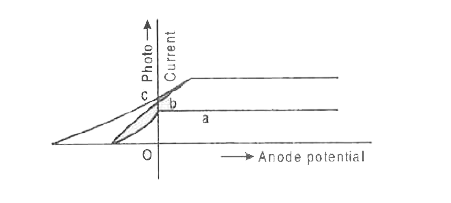The fig. shows the variation of photon current with anode potential for a photo-sensitive surface for three different radiation. Let Ia,IbandIc be the intensities and fa,fbandfc be the frequency for the curves a,b and c respectively.
 Solution in Gujrati
Solution in Gujrati
fa=fb
Ia<Ib
fc<fb
Ic>Ib
The correct Answer is:C
Here IB=IC>Ia and fc>fa=fb
Topper's Solved these Questions
- SIMPLE HARMONIC MOTIONBOOK - ALLEN CHAPTER - SIMPLE HARMONIC MOTIONEXERCISE - Exercise-01
117 Videos
- SIMPLE HARMONIC MOTIONBOOK - ALLEN CHAPTER - SIMPLE HARMONIC MOTIONEXERCISE - Exercise-02
19 Videos
- SIMPLE HARMONIC MOTIONBOOK - ALLEN CHAPTER - SIMPLE HARMONIC MOTIONEXERCISE - Example
1 Videos
- RACEBOOK - ALLEN CHAPTER - RACEEXERCISE - Basic Maths (Wave Motion & Dopplers Effect) (Stationary waves & doppler effect, beats)
25 Videos
- TEST PAPERBOOK - ALLEN CHAPTER - TEST PAPEREXERCISE - PHYSICS
4 Videos
Similar Questions
The equation of motion of a particle of mass 1g is d2xdt2+π2x=0, where x is displacement (in m) from mean position. The frequency of oscillation is (in Hz)
View SolutionA mass M is performing linear simple harmonic motion. Then correct graph for acceleration a and corresponding linear velocity v is
View SolutionA rod with rectangular cross section oscillates about a horizontal axis passing through one of its ends and it behaves like a seconds pendulum, its length will be
View SolutionThe frequency of a radar is 780 MHz. After getting reflected from an approaching aeroplane, the apparent frequency is more than the actual frequency by 2.6 kHz. The aeroplane has a speed of
View SolutionChoose the correct statement:
View SolutionThe curves (a),(b),(c) and (d) show the variation between the applied potential difference (V) and the photoelectric current (i) , at two different intensities of light (I1>I2). In which figure is the correct variation shown ?
View SolutionIn the study of transistors as an amplifier, if α=Ic/Ic and β=Ic/Ib, where Ic,Ib and Ie are the collector, base and emitter currents, then
View SolutionThe fig. shows the variation of photon current with anode potential for a photo-sensitive surface for three different radiation. Let Ia,IbandIc be the intensities and fa,fbandfc be the frequency for the curves a,b and c respectively.

View Solutionचित्र में तीन विभिन्न आपतित विकिरणों के लिए, एक फोटो-सुग्राही पृष्ठ से प्राप्त प्रकाशवैधुत धारा तथा एनोड विभव के बीच ग्राफ दर्शाये गये हैं । माना कि वक्रों a, b, c के संगत , आपतित विकिरणों कि तीव्रताएँ क्रमशः Ia,Ib,Ic हैं तथा आवृत्तियाँ क्रमशःfa,fb,fc हैं । निम्नलिखित में कौन-सा कथन सत्य है ?

View SolutionPlota graph showing the variation of photo current vs collector potential for three difference intensities I1>I2>I3 two of which (I2 and I2) have the same frequency v and the third has frequency v1>v.
View Solutionचित्र में संग्राहक विभव एवं प्रकाश वैधुत धारा के मध्य तीन वक्र (a), (b) व (c) प्रदर्शित हैं | तीनों वक्रों के संगत प्रकाश की तीव्रताएँ क्रमशः I1,I2 व I3 हैं आवृत्तियाँ , क्रमशः v1,v2

व हैं | दो ऐसे वक्र चिन्हित कीजिए जिनकी आवृत्ति समान हो परन्तु तीव्रता भिन्न हो |
View SolutionThe figures shows th variation of photocurrent i with anode potential V for three differential radiations. Let I_(a)I_(b)" and " I_(c) be the intensities and f_(a),f_(b)" and " f_(c) be the frequencies for the curves a, b and c respectively . Then
View SolutionFig. shows variation of photocurrent with anode potential for photosensitive surface for three different radiations. Let Ia,Ib and Ic be the intensities and fa,fb and fc the frequencies for curves a, b to c, then:

View SolutionIn the following figure shows the variation of photocurrent with potential of the collector plate for a photosensitive surface for three different radiations. Let Ia,IbandIc be the intensities and fa,fbandfc be the frequencies for the curves a, b, and c, respectively.

View SolutionThe fig. shows the variation of photon current with anode potential for a photo-sensitive surface for three different radiation. Let Ia,IbandIc be the intensities and fa,fbandfc be the frequency for the curves a,b and c respectively.

View SolutionThree particles A, B and C of mass m, m and 2m lie in a straight line as shown. The only force acting on these particles is due to the gravitational attraction towards each other. Let the magnitude of net force on them be F_(A), F_(B) and F_(C ) respectively. Then, F_(A):F_(B):F_(C ) is equal to :
View Solution
